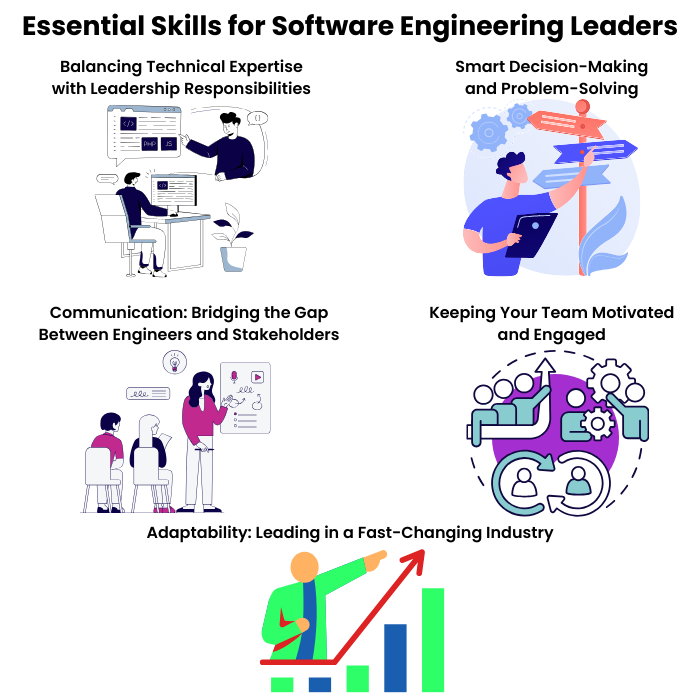Software engineering leadership is more than just managing developers—it’s about guiding a team toward building high-quality, scalable, and efficient software solutions while ensuring alignment with business goals. Strong leadership creates a culture of innovation, collaboration, and continuous improvement, helping engineers perform at their best.
Without effective software engineering leadership, teams can struggle with unclear priorities, inefficient workflows, and a lack of direction. A great leader bridges the gap between technical execution and business strategy, making sure software projects stay on track and deliver real value.
This guide explores the core skills, strategies, and best practices that define strong software engineering leadership. Whether you’re stepping into a leadership role or looking to refine your approach, you’ll find actionable insights to lead your team with confidence.
Core Skills Every Software Engineering Leader Must Have
You know, leading a software team isn’t just about being the best coder in the room. It’s about balancing technical knowledge with leadership skills to keep your team moving in the right direction. You’ve probably seen teams with great developers but no clear leadership—things get messy fast. Deadlines slip, communication breaks down, and no one knows who’s making the calls. That’s where strong software engineering leadership makes all the difference.

So, let’s talk about the five skills that separate great leaders from the ones who just “manage” teams.
1. Balancing Technical Expertise with Leadership Responsibilities
Let me ask you this—do you think a software engineering leader should still be coding every day? Some say yes, some say no, but here’s the real answer: it depends.
If you spend all your time coding, you’ll miss the big picture—strategy, planning, and team growth. But if you lose touch with technology, your decisions might not make sense for your engineers. The trick? Stay technical enough to guide your team but trust them to execute.
Think of it like coaching a basketball team. You don’t need to shoot every hoop yourself, but you must understand the plays, strategy, and strengths of each player to win the game. Your job isn’t to do the work—it’s to empower your team to do it well.
2. Communication: Bridging the Gap Between Engineers and Stakeholders
Here’s a situation I bet you’ve seen before: Engineers complain that business teams don’t “get it,” and executives say engineers don’t explain things clearly. Sound familiar? That’s because technical and non-technical teams often speak different languages—and it’s your job to translate.
Great software engineering leaders bridge this gap by explaining technical concepts in a way business teams can understand while ensuring engineers see the bigger picture. But here’s the catch—communication isn’t just about talking, it’s about listening too.
Have you ever had a manager who always talked over you, never really hearing your concerns? Frustrating, right? The best leaders don’t just give orders—they listen, provide meaningful feedback, and create space for honest conversations. That’s how you build trust and a team that actually works together.
3. Smart Decision-Making and Problem-Solving
Every software project comes with surprises—shifting requirements, unexpected bugs, or that one task that takes way longer than expected. So, what do you do when things start going south?
You stay calm and make smart, data-driven decisions. A great software engineering leader doesn’t panic or blame people when problems arise. Instead, they step back, look at the facts, and decide what really matters.
The secret? Prioritization. Not every issue needs to be solved immediately. A good leader knows how to balance short-term fixes with long-term stability so the team isn’t drowning in technical debt six months later.
4. Keeping Your Team Motivated and Engaged
Let’s be real—most developers don’t wake up excited just because they’re writing code. What really drives them? Meaningful work, challenges, and recognition.
Think about a time when you worked on a project that actually excited you. You probably felt more focused, more creative, and more productive, right? That’s what good leadership does—it gives engineers a sense of purpose beyond just finishing tickets.
And here’s a little secret: Money isn’t the biggest motivator. Sure, it’s important, but people also want to learn, to grow, and to feel valued. If you’re not recognizing their work, encouraging skill development, or giving them ownership, they’ll check out—even if they don’t quit.
5. Adaptability: Leading in a Fast-Changing Industry
Technology moves fast. What’s popular today might be outdated next year. That means as a leader, you can’t afford to get stuck in your ways.
I’ve seen leaders who resist change because “this is how we’ve always done it.” And guess what? Their teams struggle to keep up. Meanwhile, the best leaders are always learning, adapting, and encouraging their teams to do the same.
You don’t need to jump on every new trend, but you do need to stay ahead of the curve. Whether it’s cloud computing, AI, or the latest development frameworks, great leaders make sure their teams aren’t just keeping up—they’re staying ahead.
So, there you have it—the five skills every software engineering leader needs. Master these, and you won’t just manage a team—you’ll lead them to success.
Building and Managing High-Performing Software Teams
A high-performing software team doesn’t happen by accident—it’s built with purpose. Even the best engineers will struggle without clear leadership, the right culture, and strong collaboration. So, how do you build and manage a team that delivers consistently? Let’s break it down.
1. Hiring Engineers Who Bring More Than Just Coding Skills
Hiring isn’t just about finding great coders—it’s about finding great teammates. A strong engineer can write clean code, but a great one can communicate, collaborate, and think critically.
When hiring, ask:
- Can they break down complex problems clearly
- Do they work well with others and share knowledge?
- Are they open to learning and adapting?
A team full of solo performers won’t succeed. You need engineers who build together.
2. Onboarding & Training: Setting Engineers Up for Success
Ever seen a new hire lost for weeks because no one guided them? That’s bad onboarding.
A smooth onboarding process should:
- Define clear expectations from day one.
- Provide good documentation—no one should rely on memory alone.
- Assign a mentor—having a go-to person speeds up learning.
But onboarding doesn’t stop after week one. Continuous learning—through code reviews, training, and peer collaboration—keeps your team sharp.
3. Creating a Culture of Collaboration & Innovation
A high-performing team isn’t just a group of smart people working alone—it’s a group that shares ideas, learns together, and challenges each other.
Encourage:
- Knowledge-sharing—no hoarding information, document and discuss.
- Constructive feedback—engineers should feel safe questioning ideas.
- Experimentation—if failure isn’t an option, neither is innovation.
If your team trusts each other and the process, you’ll build better software—faster.
4. Managing Remote & Hybrid Teams Effectively
Remote work isn’t the future—it’s already here. But without structure, it leads to poor communication and isolation.
To keep remote teams strong:
- Set clear goals—outcomes over hours worked.
- Communicate openly—Slack, standups, async updates.
- Encourage connection—virtual or in-person, teams need bonding.
A remote team can be just as effective as an in-office one—if you lead them well.
5. Handling Conflicts & Keeping Morale High
Every team has conflicts—but leaders decide whether they become problems or growth opportunities.
- Spot issues early—if something feels off, address it.
- Encourage open conversations—people need to feel heard.
- Recognize wins—morale stays high when effort is valued.
A team that trusts their leader and each other will handle challenges without falling apart.
A great software team isn’t just about skill—it’s about culture, communication, and leadership. Get these right, and you won’t just have a team that delivers—you’ll have one that thrives.
Leading Software Projects and Driving Productivity
Great software engineering leadership isn’t just about managing people—it’s about delivering results without burning out your team. Software projects can easily spiral out of control with missed deadlines, unclear goals, and constant changes. A strong leader keeps projects on track, maintains team productivity, and ensures software quality stays high.

Let’s break down the essentials of leading projects effectively while keeping your team engaged.
1. Project Planning and Execution: Clear Goals, Smooth Delivery
A software project without a clear plan is like driving without a map—you’ll waste time, miss turns, and probably never reach your destination.
A good leader makes sure every project starts with:
- Well-defined goals – What are we building, and why does it matter?
- Milestones and priorities – Break the work into smaller, trackable steps.
- Ownership and accountability – Every engineer should know their role.
And here’s the key: balance speed with quality. If you push too hard for quick delivery, you’ll rack up technical debt—but if you overanalyze everything, the project drags forever. Find the right pace to ship efficiently without sacrificing stability.
2. Managing Deadlines, Expectations, and Deliverables
Ever worked on a project where deadlines kept shifting, and no one knew what was happening? That’s a leadership failure.
Good leaders set realistic deadlines based on actual team capacity—not wishful thinking. They also:
- Prevent scope creep – Every added feature delays delivery. Control it.
- Set expectations early – Keep stakeholders informed so there are no surprises
- Communicate roadblocks – If there’s a delay, flag it early instead of scrambling at the last minute.
The best software leaders don’t just manage time—they manage expectations.
3. Agile Leadership and Adapting to Change
Software projects rarely go 100% according to plan. Agile leadership means being flexible while keeping the team focused.
To lead effectively in an Agile environment:
- Break work into sprints – Smaller, frequent releases keep progress visible.
- Be open to change – Priorities shift; adapt without losing momentum.
- Remove bottlenecks – If engineers are stuck, it’s your job to clear the path.
Agile isn’t just about daily standups—it’s about keeping projects moving, even when requirements evolve.
4. Measuring Team Performance and Software Quality
If you don’t measure progress, how do you know if your team is productive? Software engineering leadership isn’t just about moving fast—it’s about ensuring quality work gets delivered on time.
Key things to track:
- Cycle time – How long does it take to ship a feature?
- Code quality – Are pull requests getting reviewed properly?
- Incident rates – How often are bugs and outages happening?
But don’t obsess over numbers. Metrics are just indicators—the real goal is to build efficient teams that deliver great software.
A great software leader makes sure projects move forward without overworking the team or sacrificing quality. Planning, clear expectations, adaptability, and tracking performance keep everything under control.
How Can Overcoming Impostor Syndrome Enhance Skills and Strategies for Software Engineering Leadership?
Overcoming impostor syndrome in leadership roles allows software engineering leaders to embrace their expertise confidently. This mindset shift fosters better decision-making, clearer communication, and a willingness to seek feedback. By tackling self-doubt, engineers can cultivate collaborative environments, inspire their teams, and ultimately drive innovation and success within their organizations.
Conflict Resolution and Leadership Under Pressure
No matter how well you lead, conflicts and setbacks are inevitable in software engineering. Maybe it’s a disagreement over architecture, a missed deadline, or a frustrated team member feeling unheard. A weak leader ignores these problems until they explode. A strong leader spots them early, addresses them head-on, and keeps the team moving forward.
Let’s break down how to handle conflicts, manage stress, and lead under pressure—without losing your team’s trust.
1. Identifying and Addressing Team Conflicts
Every software team has disagreements—whether it’s about technical decisions, coding standards, or project priorities. The key isn’t avoiding conflict but handling it productively.
Here’s how to keep conflicts from turning into bigger issues:
- Spot the signs early – Tension in meetings? Lack of collaboration? It’s time to step in.
- Encourage open discussions – Let team members explain their perspectives without shutting each other down.
- Focus on solutions, not egos – What’s best for the project, not who “wins” the argument?
- Make the final call when needed – If a decision must be made, own it and explain why.
Good conflict resolution turns disagreements into learning moments instead of roadblocks.
2. Handling Project Failures and Setbacks
Let’s be real—not every project goes as planned. Deadlines slip, bugs cause delays, and sometimes, a feature just doesn’t work. The difference between a good leader and a bad one? How they respond when things go wrong.
Instead of blaming the team or panicking:
- Stay calm and assess the situation – What went wrong, and why?
- Communicate with transparency – Hiding mistakes makes things worse. Be honest.
- Find the lesson – Every failure teaches something. What can be improved next time?
- Keep the team motivated – If people feel defeated, progress slows. Show them the way forward.
The best engineering leaders turn failures into learning opportunities, not disasters.
3. Managing Stress and Preventing Burnout
Software development is demanding, and if you push too hard, burnout follows. A stressed-out, overworked team won’t produce quality code—they’ll just burn out and leave.
How to prevent burnout:
- Set realistic workloads – Don’t overload engineers with never-ending tasks.
- Encourage breaks – A well-rested mind solves problems faster.
- Recognize effort, not just results – Even failed projects require hard work.
- Lead by example – If you’re always stressed, your team will be too.
Keeping your team healthy isn’t just good for morale—it’s good for business.
4. Leading with Transparency and Accountability
A great software engineering leader doesn’t shift blame or hide mistakes. They own their decisions, admit when they’re wrong, and create a culture of trust.
- To build accountability in your team:
- Be honest about challenges – If there’s a roadblock, address it openly.
- Take responsibility for failures – The best leaders own mistakes instead of blaming the team.
- Give credit where it’s due – Recognize and celebrate great work.
A transparent leader earns respect, trust, and long-term success.
Conflicts, failures, and stress are part of software engineering—but great leadership ensures they don’t derail progress. The best leaders face challenges head-on, support their team, and keep projects moving forward.
Conclusion: Becoming a Strong Software Engineering Leader
Software engineering leadership isn’t just about managing projects or making technical decisions—it’s about building great teams, keeping projects on track, and ensuring engineers thrive in a fast-moving industry. A strong leader balances technical expertise with communication, decision-making, and adaptability to create an environment where software gets built efficiently and teams stay motivated.
We’ve covered everything from core leadership skills to handling conflicts and leading under pressure. But leadership isn’t a checklist—it’s an ongoing process of learning, adapting, and improving. The best leaders don’t have all the answers, but they know how to guide their teams toward success.
So, what’s next? Take action. Apply what you’ve learned, refine your leadership approach, and keep growing. Because the best software engineering leaders aren’t just great at coding or management—they’re great at bringing people together to build something meaningful.




